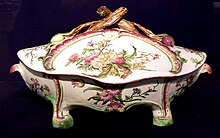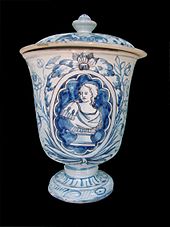Faience

Faience or faïence (
English generally uses various other terms for well-known sub-types of faience. Italian tin-glazed earthenware, at least the early forms, is called maiolica in English, Dutch wares are called Delftware, and their English equivalents English delftware, leaving "faience" as the normal term in English for French, German, Spanish, Portuguese wares and those of other countries not mentioned (it is also the usual French term, and fayence in German). The name faience is simply the French name for Faenza, in the Romagna near Ravenna, Italy, where a painted majolica ware on a clean, opaque pure-white ground, was produced for export as early as the fifteenth century.

Technically, lead-glazed earthenware, such as the French sixteenth-century Saint-Porchaire ware, does not properly qualify as faience, but the distinction is not usually maintained. Semi-vitreous stoneware may be glazed like faience. Egyptian faience is not really faience, or pottery, at all, but made of a vitreous frit, and so closer to glass.
In English 19th-century usage "faience" was often used to describe "any earthenware with
History
Western Mediterranean
The
"
In Italy, locally produced tin-glazed earthenwares, now called maiolica, initiated in the fourteenth century, reached a peak in the late fifteenth and early sixteenth centuries. After about 1600, these lost their appeal to elite customers, and the quality of painting declined, with geometric designs and simple shapes replacing the complicated and sophisticated scenes of the best period. Production continues to the present day in many centres, and the wares are again called "faience" in English (though usually still maiolica in Italian). At some point "faience" as a term for pottery from Faenza in northern Italy was a general term used in French, and then reached English.[3]
French and northern European faïence

The first northerners to imitate the tin-glazed earthenwares being imported from Italy were the Dutch.
In France, the first well-known painter of faïence was
The products of faience manufactories are identified by the usual methods of ceramic connoisseurship: the character of the clay body, the character and palette of the glaze, and the style of decoration, faïence blanche being left in its undecorated fired white slip. Faïence parlante (especially from Nevers) bears mottoes often on decorative labels or banners. Apothecary wares, including albarelli, can bear the names of their intended contents, generally in Latin and often so abbreviated to be unrecognizable to the untutored eye. Mottoes of fellowships and associations became popular in the 18th century, leading to the faïence patriotique that was a specialty of the years of the French Revolution.
"English delftware" produced in Lambeth, London, and at other centres, from the late sixteenth century, provided apothecaries with jars for wet and dry drugs, among a wide range of wares. Large painted dishes were produced for weddings and other special occasions, with crude decoration that later appealed to collectors of English folk art. Many of the early potters in London were Flemish.[4] By about 1600, blue-and-white wares were being produced, labelling the contents within decorative borders. The production was slowly superseded in the first half of the eighteenth century with the introduction of cheap creamware.
Dutch potters in northern (and Protestant) Germany established German centres of faience: the first manufactories in Germany were opened at Hanau (1661) and Heusenstamm (1662), soon moved to nearby Frankfurt. In Switzerland, Zunfthaus zur Meisen near Fraumünster church houses the porcelain and faience collection of the Swiss National Museum in Zürich.
By the mid-18th centuries many French factories produced (as well as simpler wares) pieces that followed the Rococo styles of the French porcelain factories and often hired and trained painters with the skill to produce work of a quality that sometimes approached them.
The products of French faience manufactories, rarely marked, are identified by the usual methods of ceramic connoisseurship: the character of the

In the course of the later 18th century, cheaper
Revival
In the 19th century two
Ancient frit wares called "faience"

The term faience broadly encompassed finely glazed ceramic beads, figures and other small objects found in
Types

Many centres of traditional manufacture are recognized, as well as some individual ateliers. A partial list follows.
France
- Nevers faience
- Lyon Faience
- Rouen faience
- Marseille: Veuve Perrin, Gaspard Robert, Joseph Fauchier, Honoré Savy and other factories
- Quimper faience
- Niderviller pottery
- Aprey Faience
- Moustiers faience, of the Ateliers Clérissy
- Strasbourg faience
- Lunéville Faience
- Gien Faience, including the Faïencerie de Gien
- Creil-Montereau faience
- Mesves sur Loire faience
- Montpellier faience
- Saint-Porchaire ware, for comparison
Italy

- Laterza faience
- Savona faience
- Turin faience
- Lodi faience
Spain
- Manises (faience manufactory)
- Royal Factory of Alcora faience
- Royal Factory of La Moncloa
- Royal Factory of Sargadelos
- Talavera de la Reina pottery
Germany
- Abtsbessingen faience
- Hanau faience (1661–1810) – first producer in Germany
- Nürnberg faience
- Öttingen–Schrattenhofen faience
- Poppelsdorf(1755–1829)
- Proskau faience – biggest Silesian producer (1763–1853)
- Schleswig faience
- Stockelsdorf faience
- Stralsund faience (closed 1792)
England
Denmark
Netherlands
- Boerenbont
- Delftware
- Gouda (pottery)
- Koninklijke Porceleyne Fles
- Loosdrechts Porselein
- Regina (pottery)
- Royal Tichelaar
- Weesp Porselein
Norway
Sweden
Austria
- Gmunden (pottery)
Mexico
- Talavera (pottery)
Canada
United States
- California Faience (Berkeley)
- Ephraim Faience Pottery
- Herman Carl Mueller, Mueller Mosaic Company, Trenton, New Jersey
- Lonhuda Pottery Company
- Weller pottery
- Florida Faience, Martin Cushman, (Mt Plymouth Fl)
See also
- Clockarium
- Delftware
- Lusterware
- Musée de la Faïence de Marseille
Notes
- ISBN 1472584430, 9781472584434, google books
- ^ "the larger one" in Medieval Latin and Italian, as opposed to Menorca, "the smaller one" of the Balearic Islands
- ^ Alan Caiger-Smith, 1973. Tin-Glazed Pottery (London: Faber and Faber).
- ^ (Royal Pharmaceutical Society) "English Delftware Storage Jars" Archived 2007-10-06 at the Wayback Machine
- ISBN 0300083874, 9780300083873, google books
- ^ 1862, Editorial Staff, Art Journal Catalogue, Exhibited Class XXXV, no.6873, D78., page #:8 https://archive.org/details/artjournalillust1863lond/page/n25?q=1862+Art+journal+Catalogue
"The Italian Vase [top, left, p.8] is Majolica, […] the painting being executed by a process not hitherto employed. […] The Ewer [bottom, middle, p.8] is a Palissyvase.
- ^ 1999, Paul Atterbury and Maureen Batkin, Dictionary of Minton, ACC Art Books (2nd Revised edition 1 Jan. 1999), page #:124 "[…] the coloured glaze decorated wares which we now call majolica, but which Minton referred to as Palissy wares."
- ^ Carnegy, p.65
- The Walters Art Museum.
- ^ Metropolitan Museum of Art Guide, 2012[full citation needed]
- ^ Julian Henderson, The Science & Archaeology of Materials, London: ROutledge 200: 54)
- ^ W SS, 'Glazed Faience Tiles found at Kerma in the Sudan,' Museum of the Fine Arts, Vol.LX:322, Boston 1962, p. 136
- ^ Peter Lacovara, 'Nubian Faience', in ed. Florence D Friendman, Gifts of the Nile - Ancient Egyptian Faience, London: Thames & Hudson, 1998, 46-49)
- ^ C. Michael Hogan, Knossos fieldnotes, Modern Antiquarian (2007)
Bibliography
- (Royal Pharmaceutical Society) "English Delftware Storage Jars"
- German faience beer steins
- "Tin-glazed earthenware from Port Royal, Jamaica" Archaeology reveals English, Russian and Dutch wares.
- Russian national faience craft
- Russian Faience factory
External links
- . Encyclopædia Britannica. Vol. 10 (11th ed.). 1911. p. 126.
- Moustiers France
- Gien France
- Gallery of Russian faience
